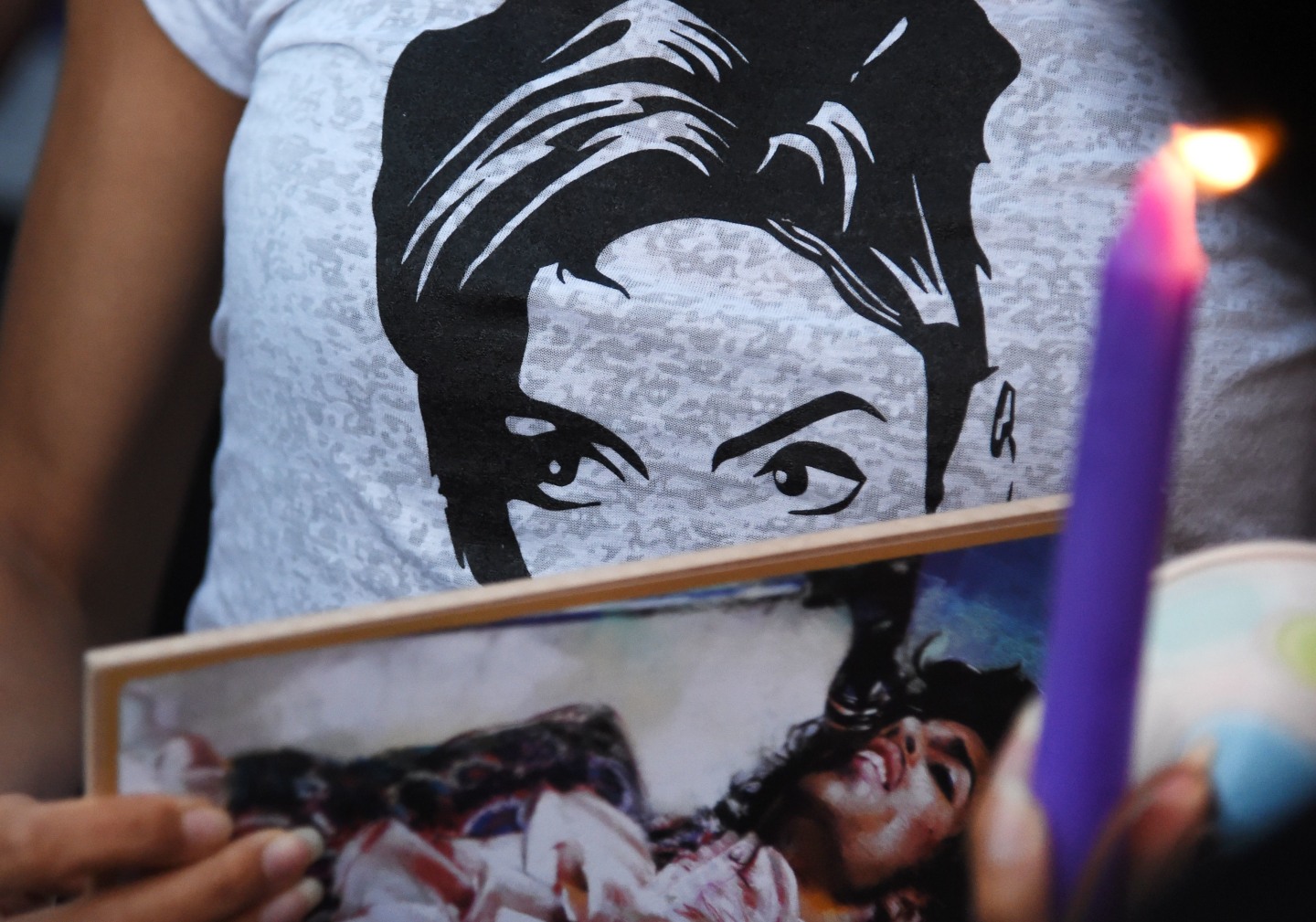 Robyn Beck / AFP / Getty Images
Robyn Beck / AFP / Getty Images
The first iPhone was released in 2007. In the near-decade since, smartphones have slimmed down while growing much more powerful and ubiquitous. Meanwhile, humans haven’t changed all that much—we’re born, we love, we hope and dream, and then we die. Only now, we have new codes and technologies through which to do what our ancestors have done for thousands of years. That much is evident on any given day: you might Skype or FaceTime with a family member an ocean away about an upcoming wedding, or you might swap texts with a friend down the block about what you intend to eat for dinner. In those instances, basic human contact does not disappear, it just changes location.
As clear as these shifts are in life, they are more so in death. When Prince died unexpectedly last month, the now-common ritual of online mourning proceeded as it now usually does—as it did when David Bowie passed this January, and when we lost Phife Dawg in March, and, with the participation of a considerably narrower sliver of the population, when Sean Price died last summer. It’s happening this week, too, following the death of Afeni Shakur on Tuesday. The first wave of simple tweets and Instagram posts often materialize like shock: various iterations of the word “no” and then a stunned stillness during which time it’s difficult to muster up much more than an “R.I.P.” or a “damn.” The joy feels briefly siphoned out of social timelines.
What comes next has become predictable, too. Blanket statements of acknowledgment are replaced by more personal messages: reflections on fandom, favorite memories, and indelible images. There are subtle differences, though. Prince didn't actively participate in the contemporary hamster wheel of fame; he valued privacy always and treated the internet with the extreme skepticism of an ideologue. As a staunch defender of artists’ rights and an outspoken critic of the music industry, he had recently made TIDAL the only place online where his catalogue could be accessed legally. So, in the absence of songs and videos that could easily be shared, photos and GIFs of him abounded: here he was sitting courtside at a Warriors game; there he was capturing a universe’s worth of shade in a single awards show eyeroll. We collected stories of other people talking about Prince and waded through scans of interviews published in now-waterlogged magazines. He might not have approved—in fact, he might’ve been incensed—but that mattered little to the internet.
Processing the death of a public figure—and especially the kind, like Prince, whose existence can seem almost theoretical simply because they are mostly knowable through their art—is complicated. It can feel good, and even necessary, to honor and respect and celebrate the lives of artists who’ve extended the limits of human imagination, or activists who’ve made the world a better place. On the days Bowie and Prince died, and in the days that followed each occasion, the internet quickly became awash with listicles and tributes and thinkpieces and interviews with their friends and collaborators, live Q&As and podcasts dissecting every possible iota of their respective existences—their music, style, politics, persona, career, legacy.
At its best, that content can further a dialogue. At its worst, it piles more 1s and 0s into the growing chaos of information pollution brought on by the latest stage of online media’s evolution. In the wake of Prince’s death, for instance, MTV News took to Facebook Live, the broadcasting technology thus far best known for hosting BuzzFeed’s exploding watermelon experiment, to eulogize him on the fly. Reporters for the network anchored a livestream that featured both commentary and interviews; viewers watched as the network’s newly re-launched digital arm tried—perhaps valiantly, perhaps cynically—to test out the platform’s use cases.
It's a weird time: coinciding with the new reality that icons from a bygone, pre-internet era are getting older and dying are new attitudes, new technologies, and new avenues for creating and monetizing media. These changes have produced engaging work, but, in some cases, they’ve also blurred the the line between what feels like collective mourning and what feels like assembly-line content farming.
Elsewhere, Genius news managing editor Leah Finnegan used Genius’s new annotation tool to critique a personal essay memorializing Prince written by New York writer-at-large Rembert Browne. She interrogated Browne’s piece in particular and more broadly questioned the media landscape that encourages reaction pieces in the form of personal narrative (a format many other publications, including The FADER, often publish). Finnegan’s critique can be summed up by her snarky, but understandable, suggestion of the alternate headline, “How Prince’s Death Is About Me.” An opposing response from Genius user dathowizer is understandable, too: “It would seem to me that journalism often benefits from the writer’s perspective and readers, especially given this subject matter, want something easy to grab onto, such as someone’s favourite Prince song.”
When a Google search can return an instant jigsaw of an obituary, how does contemporary media fill in the blanks? How should it? Pieces like Browne’s Vulture essay and posts rounding up our favorite memories are increasingly the norm for showing love on the internet: we dig through dated webpages and the stories of strangers in search of gems in the way one might dig through stacks of boxes in an attic. Today, old photos of Afeni Shakur are being shared across the web, as are memories of her storied life. Seeing dozens of publications offer up first-person remembrances about someone's death can feel weird, and overwhelming, but the desire for writers to tell their own story is also rooted in something real. It's more or less how you would process the death of a friend or a family member, too. You’d sit around and exchange anecdotes with loved ones—yours and the deceased’s—until tears turned to laughter. You’d tell your favorite bits to people who didn’t have the privilege of knowing them.
On the evening of Prince’s death, the first round of tribute parties and events were organized, and then grew spontaneously. In New York people gathered at the Apollo Theater in Harlem, with Questlove’s guidance at Brooklyn Bowl, and on the street in Fort Greene under Spike Lee’s leadership, among other places. On my way home from work that night, I eavesdropped on a couple planning a Prince-themed house party for the coming weekend. “Should we make them wear purple?” a woman asked her partner, who replied, “I think they probably will anyway.” Scenes from all kinds of events soon flooded Instagram, Twitter, and Snapchat. People were singing and dancing, each writing obituaries with their bodies. That, it seemed, was just another way we mourn now: a block party and a tweet and a listicle are all a group dance.
